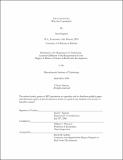The central city : why the comeback?
Author(s)
Nguyen, Scott (Scott Ti)
DownloadFull printable version (783.3Kb)
Other Contributors
Massachusetts Institute of Technology. Dept. of Architecture.
Advisor
William C. Wheaton.
Terms of use
Metadata
Show full item recordAbstract
Recently, scholars and non-scholars alike have written and spoken much about the reversal of urban sprawl and the in-migration of young professionals and empty nesters. The objective of this study is first, to examine the relative city performance for the three defined metrics to determine whether cities are leading or lagging their MSAs in each respective metric and second, to determine how differences in relative performance correlate to the independent variables. Additional analyses will be performed to determine changes in household composition and relationships between supply growth and demand growth. This paper, using OLS regression techniques, examines the correlation between various measures of relative city to MSA growth performance (specified as relative population, housing unit and property value growth) and various independent variables for a representative sample of seventy three metropolitan areas. The study period includes data from 2000 to 2004. The twenty eight independent variables can be categorized into three major groups: (1) Demographic Characteristics (2) Environmental Characteristics and (3) Transportation Statistics. The results show that, on average, central cities perform worse than their MSAs in terms of housing unit and population growth while outperforming in terms of property value growth. In central cities, housing units are growing faster than population, indicating either shrinking household size or increases in investor/second home demand. Considerable variation exists and averages do not tell the whole story. Certain independent variables, namely roadway miles and transit miles have strong correlations to relative growth metrics while others such as the city's proportion of total MSA population have no observable relationship. Another surprising result is that a city's proximity to a water amenity has negative correlation to its relative population, housing unit and property value growth rate.
Description
Thesis (S.M.)--Massachusetts Institute of Technology, Dept. of Architecture, 2006. This electronic version was submitted by the student author. The certified thesis is available in the Institute Archives and Special Collections. "September 2006." Includes bibliographical references (leaves 90-91).
Date issued
2006Department
Massachusetts Institute of Technology. Department of ArchitecturePublisher
Massachusetts Institute of Technology
Keywords
Architecture.